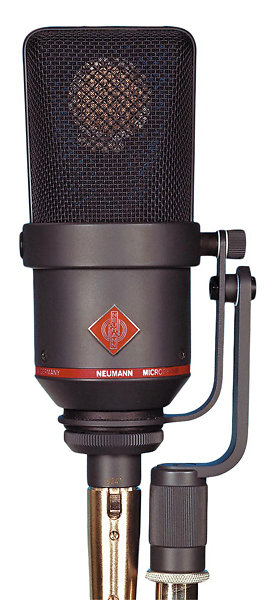Neumann - TLM 170 R mt
2 332,50 €
Out of stock
Contact us for delivery times
Warranty 3 years
Static Microphone
Studio Microphone Neumann TLM 170 R offers a clean extremely low noise level and an impressive dynamic range
ARTICLE N° 9281
Specifications
-
Microphone Neumann TLM 170 studio
-
Acoustic operating principle Pressure gradient transducer
-
Directional Omnidirectional, wide cardioid, cardioid, hypercardioid, (Figure 8)
-
Frequency response 20 Hz to 20 kHz
-
Sensitivity at 1 kHz into 1 kohm 8 mV / Pa
-
Nominal impedance 50 ohms
-
Recommended Load Impedance 1 kOhm
-
Noise level reduced to the entrance, according to CCIR 468-3 26 dB
-
Reduced noise level to entry, DIN / IEC 651] 14 dB (A)
-
Report Signal / Noise according to CCIR 468-3 68 dB
-
Signal / Noise Ratio, according to DIN / IEC 651 80 dB
-
Maximum SPL for THD = 0.5% 144 dB
-
Maximum SPL for THD = 0.5%, pre-activated 154 dB attenuator
-
Maximum output level +10 dBu
-
Dynamic Range mic preamp built according to DIN / IEC 651 130 dB
-
Ghost Supply voltage 48 V ± 4 V
-
Current consumption 3 mA
-
Output connector XLR 3M
-
Weight 625 g
-
Diameter 60 mm
-
Length 152 mm
Presentation
The TLM 170 R was the first microphone to use technology fet 100 With a symmetrical transformerless output stage, it offers a clean extremely low noise level and an impressive dynamic range.
Its five directional characteristics are chosen via a rotary switch. In the sixth position, marked "R", the directivity is controlled remotely from the N 248. No specific power cable is necessary in this case.
Its five directional characteristics are chosen via a rotary switch. In the sixth position, marked "R", the directivity is controlled remotely from the N 248. No specific power cable is necessary in this case.
Information
Capsule type
Capacitor
Application
Singing, Speaking voice, Drum / percussions, Guitar / bass amplifier, Strings instruments
Directivity
Cardioid, Hypercardioid, Supercardioid, Omnidirectional, Bidirectional (Figure-8)
Switchable pad
Yes
Switchable Bass-Cut filter
Yes
Acoustic pressure (dB)
144
Shockmount included
No
Popfilter
No
Microphone clip
Yes
Complete set
Yes
Power supply
Via +48 V phantom power supply
Connectors
XLR male 3 pins
Color
Black
Packaging
Single unit
To go further...
The microphone has at the rear a 10 dB attenuation for extremely high levels of sound pressure, and a high pass filter to remove parasites transmitted by structure-borne route.
Applications
The condenser microphone TLM 170 R is a membrane model of large diameter, with several directivities. It has its high transparency, unlike some of our other models with a strong personality.
Therefore, this microphone is used in many applications, diverse in professional recording studios in broadcast, film or television, and for semiprofessional productions The directivity is selected either at the microphone itself itself or remotely from the specific supply N 248.
Acoustic characteristics
The microphone is side impact - the Neumann logo is placed facing the sound source. The large diaphragm capsule, sheltered by the gate, has a very flat frequency response for all polar, in a relatively wide angle of incidence. The curves are flat and parallel to the curve for incidence 0 ° up to 10 kHz, for an incident angle of ± 100 °.
Practical consequence: the TLM 170 R has a very even diffuse-field response for all polar patterns. An important factor in a reverberant environment, since the reflections coming from the microphone to all directions. After uptake by the microphone, the acoustic information is not affected in their tonal quality (spectrum). This characteristic is obtained without resorting to corrective resonance effects.
Therefore, the microphone maintains an excellent impulse response, both the music on the voice, without any coloration. The capsule is elastically mounted to avoid any structure borne noise path.
Directional
Besides the usual directional characteristics (omnidirectional, cardioid and bidirectional [Figure 8]), the TLM 170 has the wide cardioid and hypercardioid directional. Relative to the cardioid, hypercardioid the more effectively attenuates sounds coming from the sides. As for the wide cardioid, it is very convenient to record sound sources deployed on a certain openness.
Remote control
248 N The remote can control remotely by varying the directivity of ± 3 V nominal 48 Volts (according to DIN standard, a tolerance of ± 4 V is permitted)
When the rotary switch directivity is in the R (such as Remote Control, the TLM 170 R measures the phantom voltage value reaching it and selects the corresponding directivity. It uses a microphone cable and an XLR connector 3 standard points, the link length of up to 300 m.
Electrical Characteristics
The letters TLM stand for "transformerless microphone" (transformerless microphone). This technology replaces the conventional output transformer by an electronic circuit, providing effective common mode rejection, and avoiding RF interference that may influence the balanced audio signal.
Usage on tripods
The TLM 170 R comes with a side tilt fixing, for attaching the microphone to poles or feet. This attachment has rubber elements, which effectively protect the microphone mechanical shock. If necessary, it can be mounted on the other side of the microphone.
When using the IC 4 cable (for example to suspend the microphone from the ceiling with the MNV 87 auditorium carrier), you must remove the attachment and support. You can then connect the microphone to the swivel connector to the cable end.
Filter and attenuation
The TLM 170 R microphone has a 10 dB switchable attenuator to avoid overload of the device following in the signal chain. A second selector, rear, attenuates frequencies below 100 Hz to eliminate unwanted vibrations transmitted by structure-borne route.
Safety and reliability
All exposed surfaces of the capsule, including membranes, are at ground potential. This technology makes them immune to electrical and atmospheric interference and contamination by particles and microscopic dust
Applications
The condenser microphone TLM 170 R is a membrane model of large diameter, with several directivities. It has its high transparency, unlike some of our other models with a strong personality.
Therefore, this microphone is used in many applications, diverse in professional recording studios in broadcast, film or television, and for semiprofessional productions The directivity is selected either at the microphone itself itself or remotely from the specific supply N 248.
Acoustic characteristics
The microphone is side impact - the Neumann logo is placed facing the sound source. The large diaphragm capsule, sheltered by the gate, has a very flat frequency response for all polar, in a relatively wide angle of incidence. The curves are flat and parallel to the curve for incidence 0 ° up to 10 kHz, for an incident angle of ± 100 °.
Practical consequence: the TLM 170 R has a very even diffuse-field response for all polar patterns. An important factor in a reverberant environment, since the reflections coming from the microphone to all directions. After uptake by the microphone, the acoustic information is not affected in their tonal quality (spectrum). This characteristic is obtained without resorting to corrective resonance effects.
Therefore, the microphone maintains an excellent impulse response, both the music on the voice, without any coloration. The capsule is elastically mounted to avoid any structure borne noise path.
Directional
Besides the usual directional characteristics (omnidirectional, cardioid and bidirectional [Figure 8]), the TLM 170 has the wide cardioid and hypercardioid directional. Relative to the cardioid, hypercardioid the more effectively attenuates sounds coming from the sides. As for the wide cardioid, it is very convenient to record sound sources deployed on a certain openness.
Remote control
248 N The remote can control remotely by varying the directivity of ± 3 V nominal 48 Volts (according to DIN standard, a tolerance of ± 4 V is permitted)
When the rotary switch directivity is in the R (such as Remote Control, the TLM 170 R measures the phantom voltage value reaching it and selects the corresponding directivity. It uses a microphone cable and an XLR connector 3 standard points, the link length of up to 300 m.
Electrical Characteristics
The letters TLM stand for "transformerless microphone" (transformerless microphone). This technology replaces the conventional output transformer by an electronic circuit, providing effective common mode rejection, and avoiding RF interference that may influence the balanced audio signal.
Usage on tripods
The TLM 170 R comes with a side tilt fixing, for attaching the microphone to poles or feet. This attachment has rubber elements, which effectively protect the microphone mechanical shock. If necessary, it can be mounted on the other side of the microphone.
When using the IC 4 cable (for example to suspend the microphone from the ceiling with the MNV 87 auditorium carrier), you must remove the attachment and support. You can then connect the microphone to the swivel connector to the cable end.
Filter and attenuation
The TLM 170 R microphone has a 10 dB switchable attenuator to avoid overload of the device following in the signal chain. A second selector, rear, attenuates frequencies below 100 Hz to eliminate unwanted vibrations transmitted by structure-borne route.
Safety and reliability
All exposed surfaces of the capsule, including membranes, are at ground potential. This technology makes them immune to electrical and atmospheric interference and contamination by particles and microscopic dust
You may also like
Accessories
Neumann - TLM 170 R mt
Neumann - TLM 170 R mt
2 332,50 €
Out of stock
Contact us for delivery times
Warranty 3 years
Spotlight on
A legendary brand for decades, present in all the major recording studios, Neumann is a guarantee of high quality and professionalism. The Beatles, Natalie Cole, Celine Dion, Bryan Adams and Beyoncé... all use this exceptional brand with the famous U87, and the TLM49 at the top of the list. In home studio, the TLM103 and TLM102 condenser microphones are the most popular. For studio sound on stage opt for the KMS105. In recent years, Neumann has also offered the high-end KH80, KH120 and KH310 monitors.






